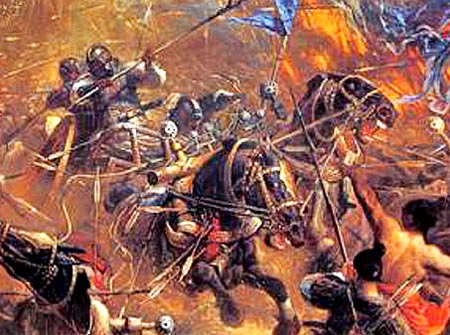 |
| An Lushan (An Lu-Shan) Rebellion |
The An Lushan Rebellion (755–763 c.e.) occurred at the midpoint of the Tang (T’ang) dynasty, 618–909, and marked a significant turning point in the fortunes of the regime. The rebellion marked the Tang’s irreversible decline after one and half centuries of good governance, economic prosperity, and military success. An Lushan’s (703–757) beginnings were humble.
He was half Sogdian and half Turk, of the Khitan tribe, and was born beyond the Great Wall of China in present-day Manchuria. At an early age he was sold to a Chinese officer of the northern garrison and rose to the rank of general and commander of a region on the northeastern frontier of the Tang empire. By the mid-eighth century c.e. most of the frontier garrisons were under foreign (non–Han Chinese) generals.
An was introduced to the court of the aging Emperor Xuanzong (Hsuan-tsung, also known as Minghuang, or “Brilliant Emperor”) and rapidly ingratiated himself to his young favorite concubine, the Lady Yang (known by her title Yang Guifei, or Kuei-fei; Guifei means “Exalted Consort”) who adopted him as her son. Gross and fat, An became a frequenter at court events, entertaining the emperor and his harem with his clowning and uncouth behavior.
  |
He was rewarded with the title of prince and given command of the empire’s best troops. Protected by Lady Yang and her brother who was chief minister of the empire, reports of General An’s treacherous intentions were not only unheeded by the emperor but the men who reported them were punished.
In 755 c.e. General An rose in rebellion. At the head of 150,000 troops, among them tribal units (he commanded a total of 200,000 troops), he marched from his base near modern Beijing toward the heartland of the empire. His success was immediate. The eastern capital, Luoyang (Loyang), fell.
With the main capital Chang’an (Ch’ang-an), poorly defended by unseasoned troops, Xuanzong and his court beat a hasty retreat, heading for refuge in the southwestern province of Sichuan (Szechwan). En route the dispirited troops escorting the emperor mutinied. They blamed Lady Yang and her brother the chief minister for their plight, killed him, and forced the emperor to hand Yang over to them and strangled her.
These humiliations led to the abdication of Xuanzong and the ascension of his son and crown prince as Emperor Suzong (Su-tsung). The doting, aged emperor’s love for his favorite, his neglect of his duties and indulgence in a sybaritic life with Lady Yang, the disastrous consequences of their love, their flight, and her tragic death have inspired many poems by famous Tang poets and were the subject of many paintings.
An Lushan’s troops entered Chang’an unopposed, and he proclaimed himself emperor, but his rebellion made little progress after that. He soon became blind and was murdered by his son in 757 c.e. The son, too, was murdered by one of his generals, and soon the rebellion degenerated into chaotic civil war as some of his early supporters defected and other rebels bands rose as opportunities offered.
The new emperor rallied loyal troops who outnumbered the rebels, but were scattered in different garrisons. He also obtained help from former vassals and allies, most notably from a Turkic tribe called the Uighurs and others in Central Asia, and even some Arab troops sent by the Islamic caliph.
Some of the help came at a high price, for example the Uighur khan who twice helped to recapture Luoyang was repaid by permission for his men to rampage through and loot the city, including the palaces and Buddhist temples, and which cost thousands of lives.
Peace was finally restored in 766; however, the empire would never recover its previous prestige and prosperity. The following are some important results of the rebellion:
- Growing importance of the army and military leaders. The army expanded to over 750,000 men. The military would remain a significant force, and regional commanders would become powerful and able to resist central control.
- Restructuring of provincial administrations that became semiautonomous through the remainder of the dynasty. This is especially significant in the decreasing amounts of revenue that local authorities would turn over to the central government, further curtailing its authority.
- Ending the land registration and distribution system in effect since the beginning of the dynasty that had ensured economic equity for the cultivators, maintained local infrastructure projects, and provided men for military service.
- Accelerating the large-scale shift of population from war ravaged areas in the Yellow River valley in northern China to southern provinces in the Huai and Yangzi (Yangtze) valleys whose productivity became crucial to the economy of the empire.
- Grievous loss of territory in the border regions because troops were withdrawn to defend the core of the empire. Central Asia was lost to Chinese control, as were Gansu (Kansu) and Ningxia (Ninghsia) Provinces. Both crucial links to the western regions. were lost to the rising Tibetan state.